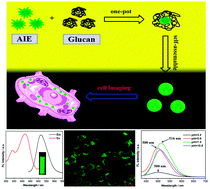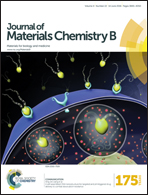Facile fabrication of amphiphilic AIE active glucan via formation of dynamic bonds: self assembly, stimuli responsiveness and biological imaging†
Abstract
Fluorescent organic nanoparticles (FONs) with aggregation induced emission (AIE) properties have recently emerged as one of the most promising luminescent nanomaterials for biomedical applications due to their unique AIE feature. In this study, we reported the preparation of AIE active FONs through mixing AIE dye (TPE-CHO), 3-aminobenzeneboronic acids (ABBA) and glucan in one-pot. ABBA acted as a molecular “bridge” to conjugate TPE-CHO with glucan via formation of a Schiff base and phenyl borate. The resultant products (Glu–TPE FONs) showed amphiphilic properties and could self-assemble into nanoparticles in an aqueous solution. Glu–TPE FONs showed strong luminescence intensity and high water dispersibility because of the AIE properties of TPE-CHO and hydrophilic nature of glucan. To examine the biomedical application potential of glucan–AIE FONs, the responsiveness, biocompatibility and cell uptake behavior of Glu–TPE FONs were subsequently examined. We demonstrated that Glu–TPE FONs possess good biocompatibility and can be potentially used for biological imaging applications. More importantly, it is well known that the Schiff base and phenyl borate can respond to pH and glucose. Therefore, Glu–TPE FONs can be used for the fabrication of multifunctional biomaterials with stimuli responsiveness.

- This article is part of the themed collection: JMC B Editor’s choice web collection: ‘‘seeing the unseen updated: advances in bioimaging’’

 Please wait while we load your content...
Please wait while we load your content...